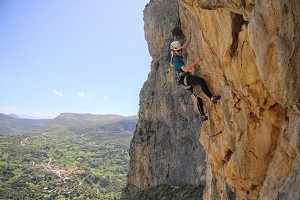
Tom Ripley shares his guide to this long-established, but out-of-vogue Greek climbing destination with sport routes for the adventurous...
Situated four hours north of Athens, Meteora is one of Europe's great unsung multi-pitch climbing destinations. When you first arrive in town, all you can see is conglomerate towers, many topped with monasteries. In terms of rock architecture it is one of the most impressive places I have visited, especially considering the semi-urban environment. Generally the routes follow strong lines and have been sparsely bolted (don't be put off; if the climbing is hard there will be a bolt nearby). This makes for very memorable climbing experiences and at the end of our week I could remember the names of most of the routes we had climbed.
History/climbing style
Meteora was first pioneered by East German climbers and has similar ethics to the sandstone towers near Elbsandstein. Routes were climbed ground-up with bolts placed by hand, on lead. The result is routes of great character, similar in a way to many of the classic routes in the Dinorwic Slate Quarries, where the first ascensionists employed an ethic known as 'designer danger'.
As a rule, none of the routes in Meteora are overly dangerous and any difficult climbing will be adequately protected. However, easier sections on climbs will often be very run out and a cool head is required. Another quirk that points to the area's East German pioneers are the little visitors books that can be found on almost every summit.
The climbing
The rock in Meteora is conglomerate — similar to but less steep than say Riglos in Spain, or Moy Rock north of Inverness. Most of the routes are multi-pitch of a similar length to a long route in the UK (four to six pitches). There are some shorter single-pitch routes too. The longest walk-in we encountered was about 30 minutes. On most days we did two routes on two different crags. A more motivated/quicker team of climbers could probably manage three or more.
Conglomerate is an interesting medium to climb on. In many ways the climbing is quite basic and surprisingly similar to indoor climbing; you either pull on the slippery pebble or crimp the concrete dish where it used to be. However, it can be a little unnerving if you stray off route, or are a long way above your last runner, when the pebbles can start to feel a little wobbly. In these situations I would advise a cautious, static, approach to climbing and employing a 'North Stack Tap' before committing. However, don't be put off, during our week long trip I only managed to break off one hold and thankfully I remained on the rock. All the routes we did had an abseil descent off solid bolted anchors.
Doupiani's North Face has a number of easier two-pitch routes and is a good place to get your eye in on day one.
Recommended routes
All of the routes we climbed during our week-long stay were excellent and would get two or three stars on any crag. However, the following four (OK - five then!) really stood out:
Seidener Faden / Silken Thread (6a+) 6a+
This is the easiest route on Adrachti (or the Spindle in English), which is one of those towers of rock that has to be seen to be believed. A slender undercut tower, steep on every side. The route is 6a+ (with an emphasis on the plus) and was probably the steepest thing we climbed on the trip. Thankfully the bolts are close together where it matters.
Linie Des Fallenden Tropfens (6a) 6a
The Line of Falling Drops is the direct route on the Sourloti formation, on an imposing and steep square cut slab, around six pitches long. It's a fantastic crag with two other classic lines, Hypothenuse (a left to right diagonal) and Sophocles, a sustained 6b. Whilst every pitch of The Line of Falling Drops is sustained at 6a, there are only one or two moves of 6a on each pitch. Although it's sparsely bolted, thankfully the climbing is all on your feet. It's the sort of route which you'll love if you love Etive Slabs, and hate if you hate Etive Slabs. (I thought it was nowhere near as gnarly as the Long Reach and would probably warrant E1 5a in our money).
Traumpfeiler (Pillar of Dreams) (6a) 6a
Heiliger Geist (Holy Ghost) is one of the main crags of Meteora, with three stand-out routes: Pillar of Dreams, Action Direct and Corner of Madness. The Pillar of Dreams is just fantastic, with bold but easy face climbing that leads into a wide chimney crack. This is quite committing, but well-protected, as long as you trust cams in concrete. More bold face climbing follows to a fantastic summit.
The classic of Heiliger Geist is absolutely brilliant. An intimidating right-facing corner, six or so pitches long. In contrast to all the other routes I did in Meteora, this is mainly crack climbing and lay-backing, with a couple of tricky wide sections and good but spaced bolts. Take a full set of cams to #4 plus doubles of #2 and #3. The final pitch is 5c but feels pretty stern. E2 5b in our money.
Eiertanz (Egg dance) (6a+) 6a+
This route's final pitches have to be seen to be believed — a conglomerate egg, roughly forty metres high, balanced on a plinth. A couple of fun pitches lead to the egg itself. To access it, you downclimb on an in situ knotted rope until you bridge across to an entertaining hanging stance. This pitch is almost certainly more intimidating to second than to lead. The final 6a+ pitch is a sheer joy. Two wild overhanging abseils get you back to the ground. There a few other towers nearby, including the Glocke and Doupiani, which are both brilliant if you want to squeeze in a second route.
Logistics
When to go
The weather in Meteora is very stable. Spring and Autumn are the best times to visit. We went in November and the conditions were excellent for climbing — neither too hot nor too cold. It can be cold and rainy in mid winter, and a little too hot in the summer (you'll want to climb in the shade and get up early).
Getting there
We flew to Athens and hired a car, which was quick and simple. Car hire in Greece at the time of writing is very cheap. The drive from the airport is about 4 hours, but mainly on good toll roads. It's a very long way to drive here from the UK, but there were plenty of climbers' vans around so it is definitely possible if you're wanting to do a bit of a road trip. A friend of mine has also travelled to Greece via train, and hired a car once there. Check out Seat 61 for more info. Another option is getting the train from Athens to Kalabaka - the main town below Meteora's crags - which takes about 7 hours.
We had a hire car, which made our life very easy. Most days, we drove 5 to 10 minutes to the crags. We'd probably have got by fine without one, but we'd have likely spent an hour a day walking to the crags and it would have made going to the big Lidl slightly trickier. We did see a few climbers hitch-hiking, too.
Where to stay, eating in and out
We stayed in a self-catering apartment in Kalabaka, which was very good value at around £100 per person for four people for seven nights. We brought most of our food from the big Lidl in Kalabaka, where you could fill your boots with Greek yogurt, feta, and halloumi, for a fraction of the UK cost. There are loads of great restaurants in Kalabaka and we probably ate out every other night. A three course meal costs about €20 per head (a real boon of eating out in Greece is they chuck in pudding free!). The coffee is also excellent. The locals are really friendly and very hospitable.
Guidebooks
The best guidebook for a one-off visit is Rock Around the World by Thierry Souchard. It has good topos, info and all the classics up to 6c. The only thing that you must climb which isn't described in that book is Adrachti / Spindel. This book is out of print in many places.
There are two local guidebooks by Vangelis Batsios. One covers modern single-pitch routes, and the other classic multi-pitches. We had all three books in our team and used Rock Around the World mostly.
Gear shops
There aren't any in Kalabaka. The nearest one is some 20km away in Trikala. I didn't visit, so I don't know what they stock. It is easy enough to order the guidebook in advance. I think you can buy it from the restaurant that is owned by the author Vangelis Batsios, but it was closed when we were there.
What to bring
A helmet! Getting a pebble to the head wouldn't end well. 50m half ropes. A small rack. Most routes require 8-10 draws. I normally carried 7-8 nuts, 4 cams and a selection of slings to supplement this. For the Corner of Madness (which was the de facto standout route) you'll want a few more quickdraws and a full set of cams up to #4. If you're not a confident wide crack climber it would be worth bringing an extra number #2 and #3 cam for this route. Crack gloves wouldn't be a bad idea - though remember they are a barrier between you and the true experience!
Also, it would be worth taking a spare belay plate so you're not totally scuppered when you drop one into the Tremadog-esque trees that are at the bottom of most routes!
We went in November and were fine in light trousers and t-shirt most of the time, with a thin fleece and windproof for climbing in the shade.
Other climbing nearby
If your brain is a little frazzled by too many wobbly pebbles, there is some conventional limestone sport climbing at Theopetra Cave about 15 mins drive from Kalabaka. Grades start at 5c. It is described in the Meteora Sport Climbing Guide by Vangelis Batsios.
- ARTICLE: 5 (V)Diffs to end all (V)Diffs 11 Jun
- PRESS RELEASE: Guided Ascent of Mount Kenya December 2024 23 Apr
- REVIEW: Mountain Equipment Vega - update of a classic 5 Apr
- REVIEW: Haglofs Roc Sheer GTX Jacket 14 Nov, 2023
- REVIEW: Edelrid Salathe Lite - the best helmet is the one you'll want to wear 13 Jun, 2023
- REVIEW: North Wales Climbs Rockfax 30 May, 2023
- DESTINATION GUIDE: Mount Kenya 30 Mar, 2023
- ARTICLE: Things I Learned While Climbing (and previously failing on) The Nose of El Capitan 17 Nov, 2022
- ARTICLE: Removing Stuck Gear 3 Nov, 2022
- ARTICLE: 12 Ways to Save Cash on Outdoor Gear 8 Sep, 2022
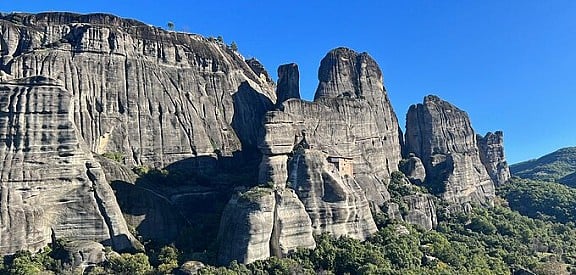
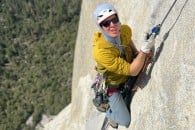

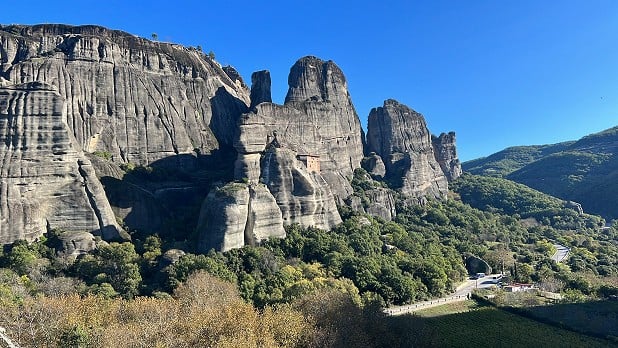
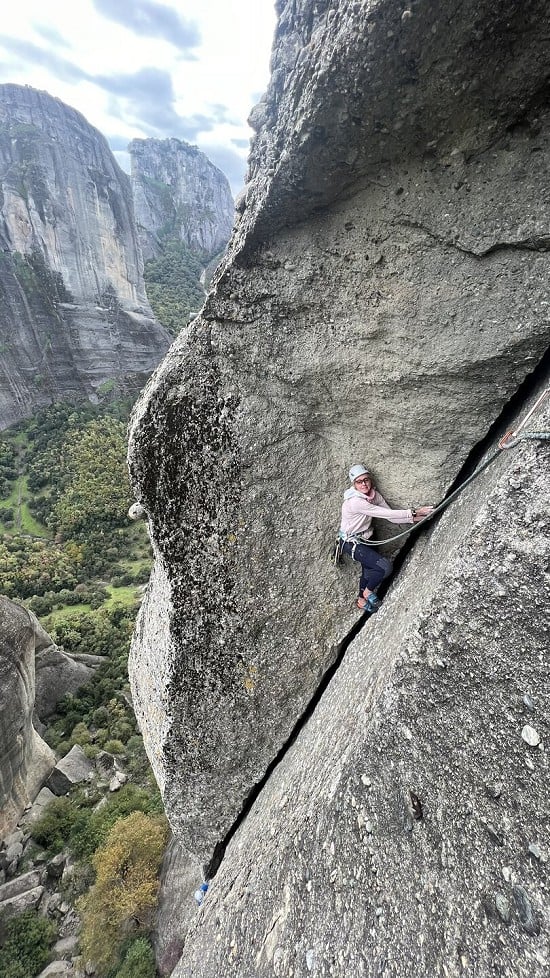
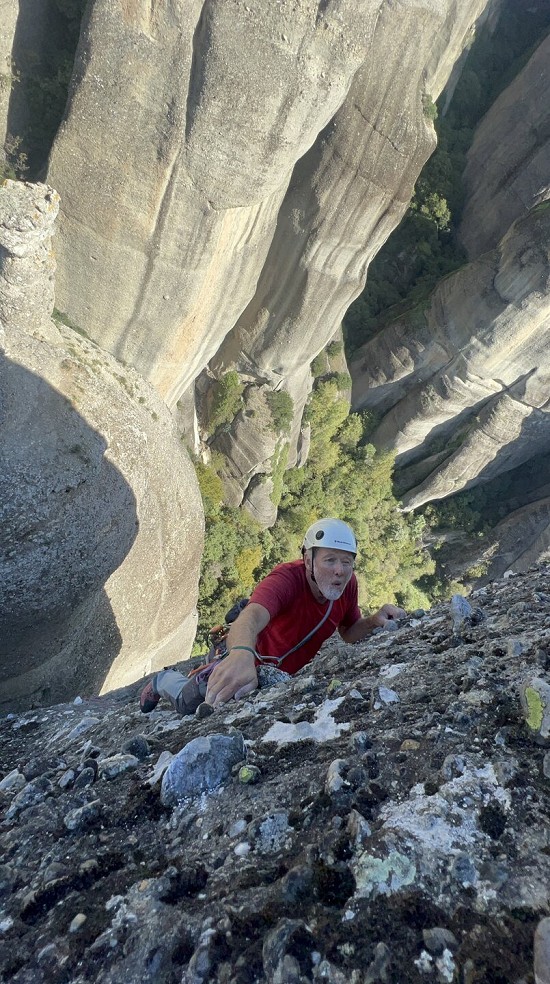
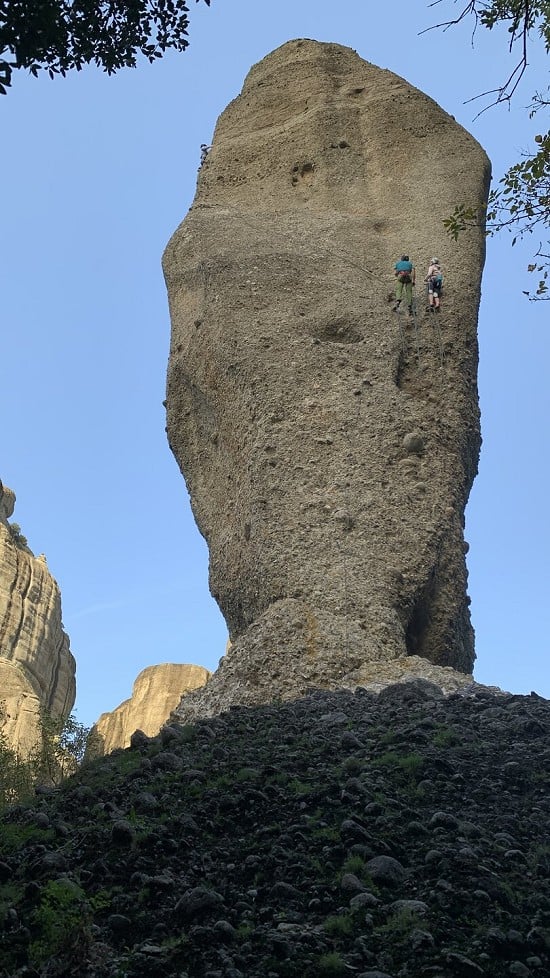
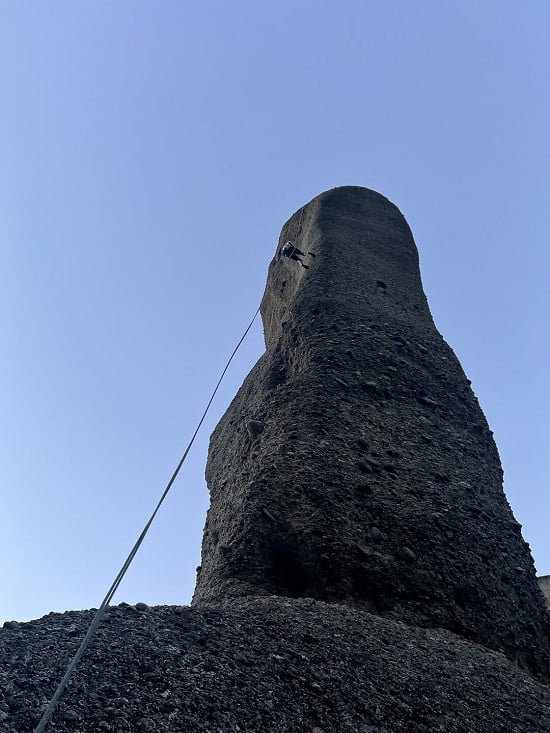
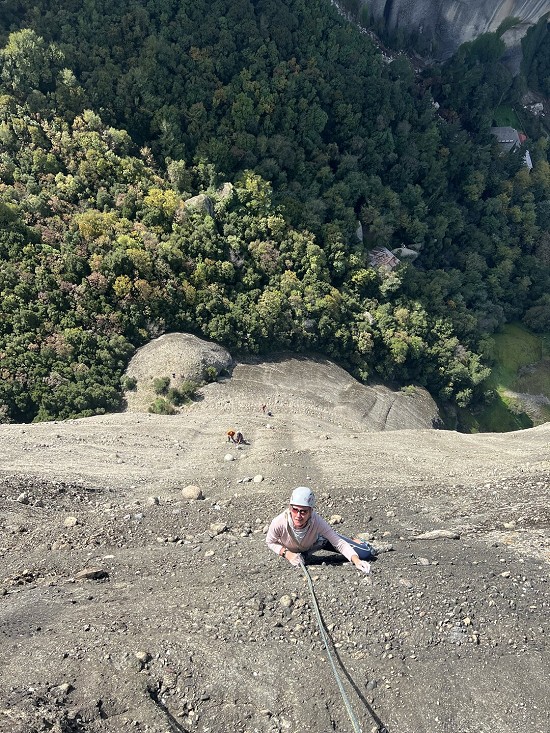


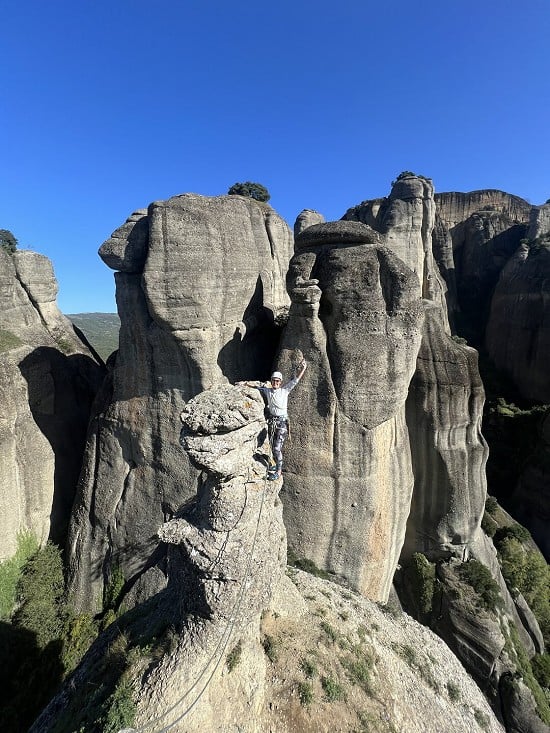
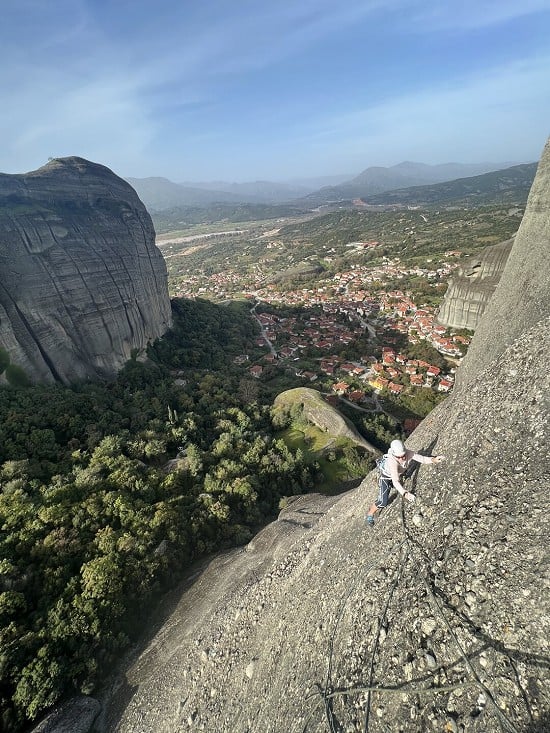
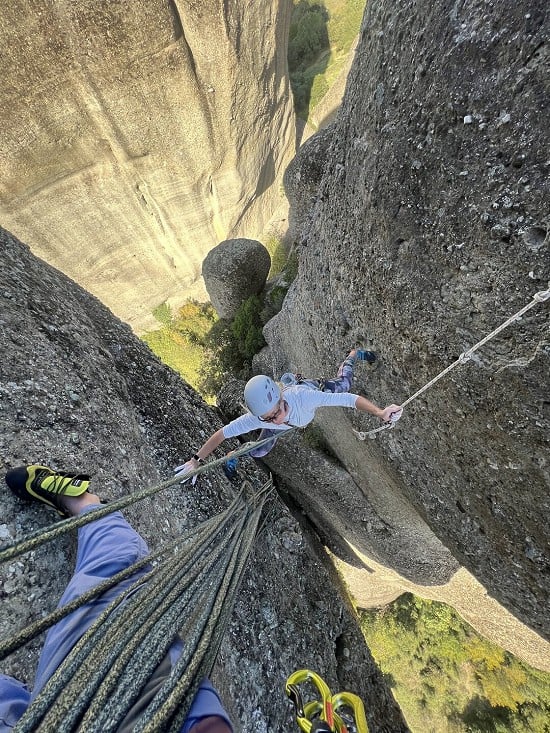

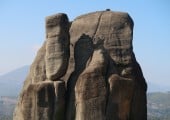
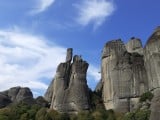
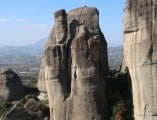
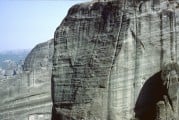

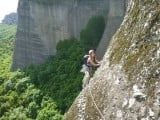



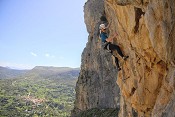
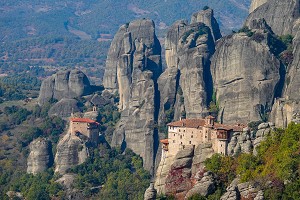
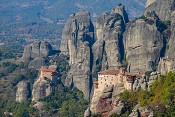


Comments
Nice write up, it's back on my radar. Looks like good adventure value in the low-mid 6's. Are there harder routes there too? And what is the quality like on them?
An interesting comparison to Moy Rock - I rate the place highly but it might be more interesting to hear how Meteora compares to Montserrat.
The comment about a spare belay plate made me smile - I did indeed drop my belay plate at Meteora and never saw it again. Glad to hear I'm not the only one.
Not been to Moy Rock, so can't compare, however the rock at Meteora was more similar to Montserrat but different to Riglos. We had a great trip to Meteora, at the end of October a few years back, weather was perfect, and agree that Corner of Madness and Pillar of Dreams are superb. Egg-dance is also a great route and we did the 6b+ (Gordian Knot) on the Spindle which was also very good - but didn't do anything harder so can't help on the quality of those. For a day off the pebbles we went to Pyli Little Gorge for more normal sport climbing, about an hour from Meteora and very worthwhile.
For Monserrat I remember Punsola-Reniu on the Cavall Bernat pillar being superb and the corner of Mas-Brullet as good and good value. And whilst I didn't drop a belay plate in Meteora I did drop one off the abseil from Cavall Bernat but did manage to retrieve that after a couple of Italian hitch abs!
I went here with two friends in March 2023. We arrived in wet weather where the rock had a greenish colour and was really slippery. I thought it was a BIG mistake as it was so sparsely bolted that we would surely die. Then the weather improved and the dry rock and sunshine seemed to improve my mind. It took a significant change of attitude to cope with the long run outs and the scare factor but as time went by we became more and more relaxed and confident with it. At the easier grade end in the 5's the runners are sparse. Maybe two or three bolts in 50 metres. When the difficulties came into the 6's they were a bit more generous with the gear. I loved the place and the spring flowers were a real pleasure. It is not crowded or popular enough to find others on your chosen route. I would recommend it to anyone as long as they are used to easy soloing and can keep a clear head and laugh at danger.
Superb article. I’ve long been meaning to go. I first saw the place on an old postcard: it pictured a monk - caught like a fish - in a net being hauled-up to a cliff-top monastery, on a rope.
I love long run-outs, so long as the moves are not desperate, and the routes you describe look wonderful. Why have I left it so long?
Many thanks.